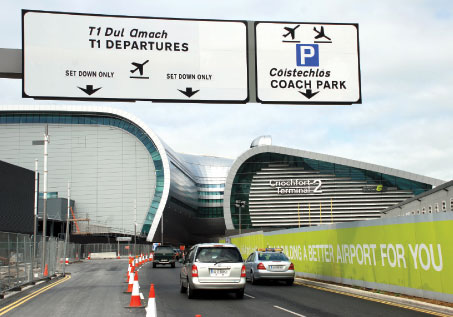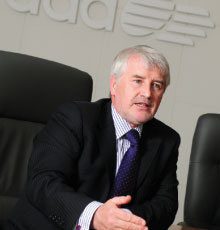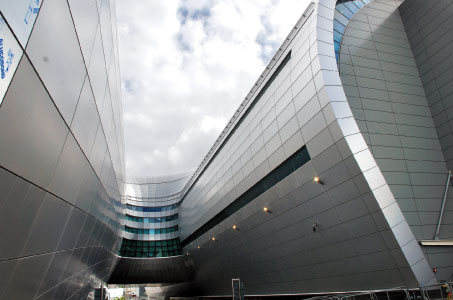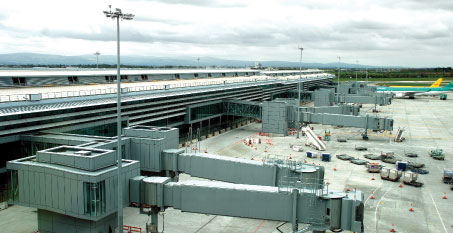
The €610 million Terminal 2 is scheduled to open in mid-November, just three years after construction work started.
The creation of T2 – a vital aspect of the wider-reaching €1.2 billion ‘Transforming Dublin Airport’ project – has seen one of the largest and most significant construction projects in the history of the Irish Republic.
Construction of the 75,000sqm terminal was effectively completed at the end of April and the full commissioning of the building and its systems is currently underway, ahead of the unveiling of the €610 million development in just a few months’ time.

Collier: “When you commit to building a project of this size, it’s not easy to stop, but it’s important to remember that we’re not building T2 just for today or tomorrow, or even for the next year; it’s for the next 30, 40 or 50 years.”
“Overall, the project is a complex one and an unusual feature of it is that it has been an extremely fast build – from start to finish, construction of T2 has taken just 29 months,” Collier explained. “It is also one of, if not the, largest construction projects in the country and it hasn’t been undertaken in the traditional way of appointing a lead contractor to oversee the project and employ various other sub-contractors; we’ve instead appointed 17 main contractors, who are overseen by the Arup, Mace and Pascall + Watson team in tandem with the DAA.”
CBP facilities
The T2 project is made up of a number of key components, which Collier says will ensure that “both passengers and airlines feel the benefit from the first day that T2 opens”.
He said: “Coming from landside through to departures, the whole wayfinding process is very simple and easy to understand. We’ve made use of the latest technologies and this has enabled us to reduce the number of check-in desks. The current terminal has 160 desks, but in T2 there will be just 58. The benefit of this is that, for instance, there will be a car park directly linked to the terminal and passengers who only have hand luggage will be able to check-in using a machine in the car park and then proceed straight to security in the terminal.”
The new US Customs and Border Protection (CBP) facilities – something only currently found in the DAA-operated Shannon Airport – is also a major facet of the new terminal.
“The CBP facilities allow passengers to clear US Customs and Immigration before boarding the flight,” Collier said. “They will then be treated as domestic passengers in the US, so the first queue they will join once they leave the plane will be the taxi queue. It also has a big benefit for the airlines as they’ll be able to save $30-40 per passenger.”
Another integral part of the T2 project is the construction of Pier E, which at 24,000sqm will provide parking for up to 19 short-haul or eight long-haul aircraft. Like the rest of the project, the new pier has been constructed with a focus on environmental efficiency.
“Sustainability and environmental awareness are a critical part of the project,” explained Collier. “We’re committed to the Airport Carbon Accreditation initiative and we’ve already worked very hard to drastically reduce the environmental impact that we have. In fact, T2 will be 26% more efficient than the current European requirement.”
Positive outlook

Collier: “Sustainability and environmental awareness are a critical part of the project and T2 will be 26% more efficient than the current European requirement.”
Since the start of the project, the DAA has been faced with the most testing economic climate in recent history. Last year, its turnover declined by 13% to €547 million, while group profit, excluding exceptional items, decreased by 51% to €38 million. In keeping with the European trend, passenger figures also fell from 23.5 million in 2008 to 20.5 million in 2009. Furthermore, the disruption caused by the volcanic ash cloud has cost the DAA as much as €8 million.
Despite this, Collier remains extremely optimistic for the future of Dublin Airport and insists that the timing is right for the introduction of Terminal 2. “You can’t choose what’s going to happen with an economic cycle and we’re going to open T2 in the middle of one of the most difficult economic situations this country has ever gone through,” he said. “When you commit to building a project of this size, it’s important to remember that we’re not building T2 just for today or tomorrow, or even for the next year; it’s for the next 30, 40 or 50 years. The economic environment will be different in five to 10 years and it’s very much a case of having to have the courage of your convictions. It’s also worth noting that economists believe that the Irish economy will have returned to growth in 2011, which will be T2’s first full year of operation.”
In order to compensate for the impact of the economic downturn, Dublin Airport Authority has put a major focus on developing its commercial revenue streams. As part of ‘The Loop’ – the commercial brand created by the DAA across all three of its airports – the commercial offering at Dublin Airport’s T2 will span 9,000sqm and will contain no fewer than 40 separate outlets.
“We derive more of our income from commercial activity than from our aeronautical activity,” Collier said. “In fact, non-aeronautical income accounts for more than 70% of overall income. You have to remember that Dublin Airport has the lowest passenger charges in Europe, and they’re among the lowest in the world, so you can see the importance of the commercial developments.”
Those passenger charges were reviewed by the Commission for Aviation Regulation (CAR) at the end of last year and while the DAA had called for a minimum increase of €3 per passenger, the regulator opted for an increase of less than €2 – a decision that Collier described as “disappointing”.
He said: “We did get an increase that was desperately needed, but we’re disappointed at the way the regulator has seen fit to only allow us an increase of this nature. We’ve said for some time that it’s important to remunerate the airport for the investment and it’s important to do it at the right time. The regulator has done the right thing at the wrong time and it puts us in a difficult situation.”

The 24,000sqm Pier E will provide parking for up to 19 short-haul or eight long-haul aircraft.
Further development
While the opening of T2 is very much at the forefront of Collier’s thinking, he also outlined that once the new terminal is up and running, plans are already firmly in place for the next stage of the long-term development of Dublin Airport.
As well as plans for a new Dublin Airport City development to the east of the airport, a new parallel runway is also high on the list of priorities. With the DAA already “deeply involved” in the planning process, Collier expects the runway to come to fruition within the next five years. For now though, both Collier and the DAA are “firmly focused and working hard to get T2 ready for the grand opening in November”.







